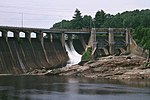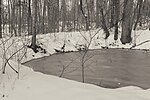Paugussett Trail

The Paugussett Trail is a 14-mile (23 km) Blue-Blazed hiking trail "system" in the lower Housatonic River valley in Fairfield County and, today, is entirely in Shelton and Monroe, Connecticut. Much of the trail is in Indian Well State Park and the Town of Monroe's Webb Mountain Park. The mainline (official "Blue-Blazed") trail is primarily southeast to northwest with three short side or spur trails. The Paugussett Trail today is composed of four (4) trails of which one is the upside-down V-shaped Southeast-to-North-to-SouthWest mainline trail (13.3 miles) plus three shorter side or access spur trails. The northernmost point on the trail is at Connecticut Route 34 and Lake Zoar's southern shore. Notable features include the initial steep climb near the Indian Well waterfall, a steep climb with stairs at Princess Wenonah Drive and semi-obscured scenic views of the Housatonic River. The Paugussett Trail is maintained largely through the efforts of the Connecticut Forest and Park Association. The Paugussett Trail was a much larger trail in the 1930s and 1940s but it has been one of the Blue-Blazed Trails most drastically shrunk by post-World War 2 housing developments.
Excerpt from the Wikipedia article Paugussett Trail (License: CC BY-SA 3.0, Authors, Images).Paugussett Trail
Old Fish House Road,
Geographical coordinates (GPS) Address Nearby Places Show on map
Geographical coordinates (GPS)
| Latitude | Longitude |
|---|---|
| N 41.38 ° | E -73.16 ° |
Address
Old Fish House Road
Old Fish House Road
United States
Open on Google Maps






